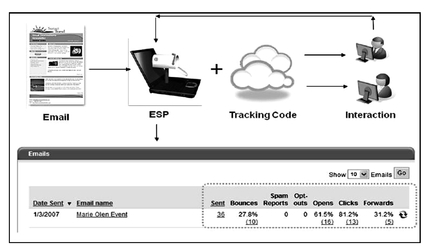How Tracking Works
Email Service Providers can help you track lots of positive and negative results, even if your audience doesn’t directly respond, and you can track direct responses back to specific individuals. Here’s how it works.
When you send an email, your Email Service Provider automatically adds special code that enables the tracking of certain responses. It’s possible to track
• Which emails bounced and why they bounced.
• Which emails received spam complaints.
• Who opted out of receiving future emails.
• Who enabled the images to display in their email.
• Who clicked the links in your email.
• Who forwarded your email to someone else.
ESPs collect and aggregate the tracking data from your emails and generate a tracking report so you can see the tracking information in an easy-to-use format (see Figure 12.1).
Email tracking data can be a bit confusing because tracking requires a combination of technology and human interaction, and both have certain limitations. The following sections show you how tracking works so you can understand the limitations and gain a realistic perspective on what your tracking data actually means.
Figure 12.1 Email tracking reports show you tracking data resulting from your email.

DELIVERY TRACKING
Your Email Service Provider can’t tell you whether a specific email was delivered to a specific recipient’s inbox, or any email folder, ...
Get The Constant Contact Guide to Email Marketing now with the O’Reilly learning platform.
O’Reilly members experience books, live events, courses curated by job role, and more from O’Reilly and nearly 200 top publishers.

